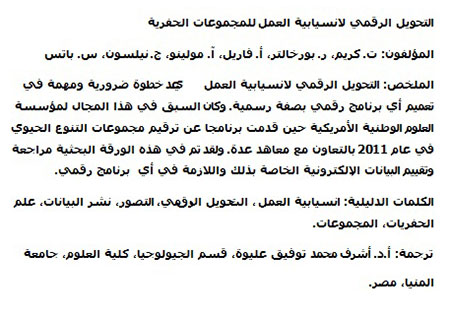Digitization workflows for paleontology collections
Plain Language Abstract
With the advent of the U.S. National Science Foundation's (NSF) Advancing the Digitization of Biodiversity Collections program in 2011, the conversion of fossil museum specimens and their associated data to digital format has made great progress. With the help of NSF funding, several networks of paleontological museums and academic collections have joined forces to create an important and rapidly growing dataset of fossil occurrence records. Working with Integrated Digitized Biocollections (iDigBio), the U.S. national coordinating center for natural history collections digitization, participating institutions have also made strides in developing, implementing, and documenting digitization workflows applicable to a wide array of fossil collections. The nine workflow modules include a well-vetted set of recommended practices that reflect current practice in fossil digitization and are designed to provide guidance to institutions just beginning formalized digitization programs as well as those searching for ways to enhance and optimize existing digitization efforts. Each module offers a series of tasks to be accomplished, detailed explanations of what each task entails, and a set of the recommended resources to ensure success. Readers are encouraged to customize these workflows for specific implementations and to effect the best match between institutional infrastructure and module implementation.
Resumen en Español
Digitalización de flujos de trabajo para colecciones paleontológicas
El desarrollo de la digitalización de flujos de trabajo es una parte esencial de cualquier programa formalizado de digitalización de gran escala. La literatura sobre colecciones paleontológicas ha mencionado la necesidad y utilidad de colecciones digitalizadas por casi cuatro décadas pero no se ha adoptado ampliamente, con este fin, ningún set moderno de digitalización de flujos de trabajo aprobado por la comunidad. Con el advenimiento en el 2011 del programa Avance de la Digitalización de las Colecciones de Biodiversidad (ADBC, Advancing the Digitization of Biodiversity Collections) de la Fundación Nacional de Ciencia (NSF, National Science Foundation) estadounidense, el iDigBio, el centro de coordinación nacional de la NSF para facilitar la digitalización, en colaboración con una amplia representación de la comunidad en distintos institutos, lanzaron una serie de grupos de trabajo para abordar el desarrollo de flujos de trabajo abarcando los principales tipos de preparación. Los módulos de flujo de trabajo han sido desarrollados para la curación pre-digitalización, ingreso de datos, escaneo de objetos (catálogos, libretas de campo y otros materiales no almacenados con los especímenes, etiquetas, especímenes preservados bi- y tridimensionalmente), escaneo y procesado de imágenes, y digitalización proactiva. Los módulos y las tareas que incluyen pueden ser implementados en cualquier orden y personalizados para configuraciones específicas y parámetros institucionales. Los flujos de trabajo son públicos y disponibles para su descarga y personalización en GitHub y vía las páginas de documentación de iDigBio. También se provee una revisión de plataformas de publicación electrónica de datos a través de agregadores online, un paso crucial en cualquier programa de digitalización.
Palabras clave: flujo de trabajo; digitalización; escaneo; publicación de datos; paleontología; colecciones
Traducción: Diana Elizabeth Fernández
Résumé en Français
in progress
Translator: Kenny J. Travouillon or Antoine Souron
Deutsche Zusammenfassung
Digitalisierungs-Arbeitsabläufe für paläontologische Sammlungen
Die Entwicklung von Digitalisierungs-Arbeitsabläufen ist ein wichtiger Teil eines jeden formalisierten Digitalisierungsprogramms. Die paläontologische Sammlungsliteratur befasst sich mit dem Bedarf an digitalisierten Sammlungen und dem Nutzen derselben nun schon seit beinahe 40 Jahre aber bisher fand kein modernes allgemein-geprüftes Set von Digitalisierungs-Arbeitsabläufen eine breite Zustimmung. Mit der Gründung des Programms "Advancing the Digitization of Biodiversity Collections (ADBC)" der U.S. National Science Foundation's (NSF) im Jahr 2011, iDigBio, hat das nationale Koordinierungszentrum zur Vereinfachung von Digitalisierung des NSF in Zusammenarbeit mit einer breiten
Gemeinschaftsvertretung von zahlreichen Institutionen eine Reihe von Arbeitsgruppen eingeführt, um die Workflow-Entwicklung in allen wichtigen Präparationstypen anzusprechen
Workflow-Module wurden entwickelt für: Prädigitalisierungs-Kuration, Dateneingabe, Abbildung von Objekten (Kataloge, Feldnotizen und andere Materialien die nicht bei den Stücken aufbewahrt werden, Etiketten, zwei-und dreidimensional erhaltene Stücke), Bildverarbeitung und proaktive Digitalisierung. Module und die Aufgaben die sie beinhalten, können in jeder beliebigen Reihenfolge umgesetzt werden und auf spezifische Konfigurationen und institutionelle Parameter angepasst werden. Die Workflows werden über den GitHub und über die iDigBio Dokumentationsseiten öffentlich zum Download zugänglich gemacht. Eine Überprüfung der Plattformen für die Publikation elektronischer Daten durch Online-Aggregatoren, ein entscheidender Schritt bei jedem Digitalisierungsprogramm, wird ebenso zur Verfügung gestellt.
Schlüsselwörter: Workflow; Digitalisierung; Bildgebung; Datenveröffentlichung; Paläontologie; Sammlungen
Translator: Eva Gebauer
Arabic

Translator: Ashraf M.T. Elewa

